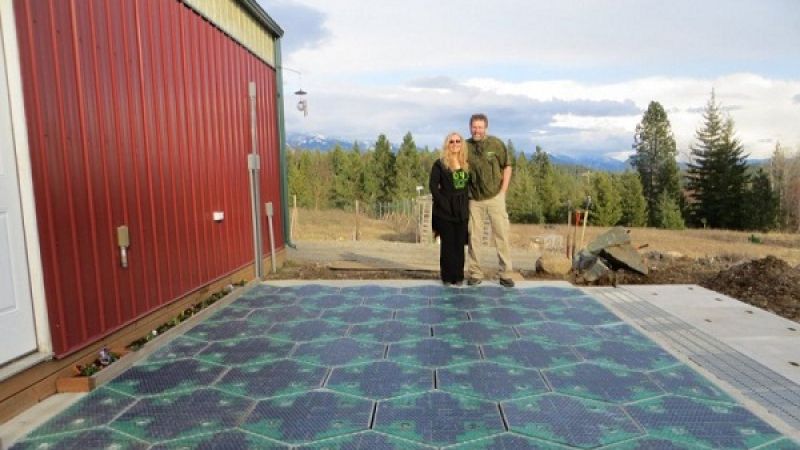Solar Roadways, an Idaho-based startup founded by the entrepreneurial and brilliant couple Scott and Julie Brusaw, has obliterated its target of $1 million in a crowdfunding campaign. The company has raised over $1.8 million to date in just over five weeks through grassroots donations.
What is a Solar Roadway?
The idea generating so much support: hexagonal tiles with embedded solar panels, LEDs, and microprocessors capable of replacing virtually any paved surface with one that is “smart” and generates electricity. They are referred to as Solar Roadways, and in theory they could solve all our problems with carbon emissions from the electricity generation and transportation sectors.
Each tile would have a special tempered glass covering capable of withstanding typical loads that road surfaces are subjected to, as the company claims their prototype meets traction, load, and impact resistance requirements. The tiles would also have a thin heating element that would prevent snow from accumulating on the surface, and the interconnected microprocessors and LEDs lend themselves to many possible advantages such as reconfigurable lanes and warning messages.
Why it won’t work
Unfortunately, we won’t see Solar Roadways in our lifetime. The most evident problem: the sheer scale and cost necessary to install enough solar roads to make an appreciable impact on electricity generation.
Solar panels are not efficient and are not cheap. The company’s plan also includes routing data cables and power lines underground, which would inflate installation costs. Solar Roadways has not provided cost information, so we can only speculate what the system would cost on a grand scale.
Others are more qualified to estimate just how much it would cost to cover our nation’s road system with these solar panels. No doubt if we made a true commitment to the idea, the scale of the project would significantly drive down costs of the components and processes involved. However, it will still likely be prohibitively expensive to revamp our entire transportation infrastructure so radically.
Is cost really the biggest problem?
Other potential issues include the obvious question of durability; the company has built a successful small-scale prototype, and they have bright engineers working on the project who are convinced the tiles can withstand the abuses of cars and enormous trucks traveling at high speeds for decades without breaking down. But if they are wrong and the tiles only last 5 years, or 10 years, the enormous investment required will effectively become a waste of money. The surface will have to endure for at least 20 years to be truly viable.
Another obvious question is, why not just put solar panels on roofs instead? There is no shortage of roofs without solar panels, and rooftop PV panels can achieve better performance than those forced to also endure the rigors of serving as a road surface.
Not beyond our capabilities
Are Solar Roadways totally out of reach? No. The technical challenges are surmountable, and it is very possible that on the scale the company envisions costs will come down to a level where it may actually be economically feasible to cover the nation with Solar Roadways that could eventually pay for themselves through electricity generation.
These are not the real problems with Solar Roadways. The real problem is that such a radical transformation would require unprecedented and universal support: from all levels of our maddeningly immovable government, from construction companies, from utilities, from the public in general who would probably have to foot a large portion of the bill.
The concept could be successful on a small scale, if certain municipalities or companies are willing to go out on a limb and make the investment. But the system will only truly work if it is everywhere, and we currently lack the money, not to mention political will and motivation, to make that happen.
But not so fast! Stay tuned here at Torque News to find out why Solar Roadways can and should happen.













Comments
Great article and a fair
Permalink
Great article and a fair treatment of the potential. The upside over roof or above ground installations is that support structure is minimal (but roadbed modifications may be needed?). The downside is the tremendous beating they must bear. But if freeze-thaw cycles are eliminated, perhaps there is a silver lining there? Looking forward to your take on the upside.
I would just like to see the
Permalink
I would just like to see the asphalt and cement roadways actually done properly. In much of the Americas plowing the roads and laying down salt and sand are a part of the real world. This just seems like another crazy idea to a person that lives above the frost line. Can't wait to see the solar roofing shingles that were right around the corner 20 (30? 40?) years ago. Those made sense and I have never seen one on a real roof.
This is such a new topic ...
Permalink
This is such a new topic ... it's basically only taken, what, nearly 80 years for real world technology to catch up with the vision proposed by Robert A. Heinlein back in 1940. Certainly he was talking more about moving sidewalks at the time as the main means of transportation similar to what we see in airports now. But he also proposed that those moving roads were powered by solar collectors on the roofs.
In a NEW construction situation - simply taking flat roofed airports or large factories - putting solar collectors on the roofs of those buildings would be great, since we'd be talking tens of acres of panels at a time. Of course, what ends up happening is the upfront cost versus the savings is the issue, same as with wind power. (Without subsidies, it takes more than the lifespan of the generator to get payback on the cost of most wind turbines today.)
All I have to say about that
Permalink
In reply to This is such a new topic ... by Carl (not verified)
All I have to say about that is "Starship Troopers."
So long as you're talking the
Permalink
In reply to All I have to say about that by John Goreham
So long as you're talking the book, and not the movie... :)
Also realize that Heinlein fully designed and described the water bed 30 years before anyone ever made them.
Indeed, although John
Permalink
In reply to So long as you're talking the by Carl (not verified)
Indeed, although John Steakley vastly improved that book when he re-wrote it as Armor. You are what you do when it counts. - - Let's not forget that Heinlien also invented the acceleration-assisted birthing chair.
They are so wrong about this,
Permalink
They are so wrong about this, solar panels are so efficient they'd be able to produce 3x the amount of power we use now, and not to mention they would cut down repair costs on roads, it would keep roads clear in the winter, it would make everything easier and better. It would pay for itself in a few years time, and more than that. Not only that, but if America has these, we'd be able to basically sell electricity to other countries in order to pay for this. This would also cut down on your electric bill immensely. Imagine looking at your bills and seeing almost nothing for your electric? Maybe a few bucks? Tell me that wouldn't make you smile. They said if we got behind it it would work, so do that, get behind it, and support it!
"They would be able to
Permalink
In reply to They are so wrong about this, by Conner Wolf (not verified)
"They would be able to produce 3x the power we produce now"? You're so naive.
And I'm naive because? That's
Permalink
In reply to "They would be able to by Dan Jones (not verified)
And I'm naive because? That's what the facts say, with that many solar panels all across America, we would produce far more energy than we use now.
haha you're naive because you
Permalink
In reply to And I'm naive because? That's by Conner Wolf (not verified)
haha you're naive because you blindly believe that it's currently possible to store all this energy in current batteries, and use it efficiently? You also think that all the solar energy just goes straight to batteries that we can use for powering anything we want, woo! You're an uneducated idiot haha.
I don't understand the basis
Permalink
I don't understand the basis for the statement "system will only truly work if it is everywhere". Not every phone was a version 1 iPhone, but that has transformed mobile phones. Especially in cold climates, I would think the cost savings of not having to plow snow not to mention the safety factor might pay for itself after a few years. Our little town just experimented with LED street lights and will be changing all the street lights to LEDs this summer. It would be cool if with their start-up $ and maybe some cost incentives some small towns can be an experimental site for these for streets or parking lot.
That's a fair point,
Permalink
In reply to I don't understand the basis by Charlotte Omoto (not verified)
That's a fair point, Charlotte. What I meant was that I believe solar roads will be prohibitively expensive unless they are deployed en masse. We don't have any cost data from Solar Roadways, and that statement may not be entirely accurate, but it is my best assumption. The company's vision certainly isn't a parking lot here, a couple driveways and a city street or two there. They hope that solar roads will eventually (far in the future, granted) be everywhere, and that is where their biggest hope lies. Not that smaller scale deployment would be a bad thing, it just wouldn't reach the full potential of the potentially transformative system. Some parallels can be drawn with Tesla - still great in small volumes, but the ultimate goal is and has to be enabled by the largest battery factory the world has ever seen.
Basically the issue is, the
Permalink
In reply to I don't understand the basis by Charlotte Omoto (not verified)
Basically the issue is, the system has a very high expense margin, even if deployed nationwide they are depending on the electricity it generates to pay it off. If it were deployed small scale and did not hit large scale soon enough it would be like igniting a match without applying it to gasoline. The idea has spark and potential but it did not receive its opportunity before the wind blew out the flame.
There are two reasons it would have to be implemented nationwide and on a fairly short time frame aswell. On small scale, the engineering costs would GREATLY exceed the profit margin by the electrical output, even if it were deployed in a few major cities it still wouldn't be enough. It would have to become a standard and not an accessory THIS way the engineering costs will level out just as well as the system could be large enough to implement enough energy to sell to exceed the cost of engineering.
While I understand what you mean about Cellphones, and they were quite entrepreneurship devices as they had to compete against land lines, cellular service is able to be implemented in an area and completely foot the bill of its engineering costs. A few cell phone towers designed and constructed with an area compared to redesigning an entire network of roads (which will also include the need to reprogram every single traffic light at every intersection and just a standard traffic signal costs in the ball park of $300,000) is comparing apples and oranges, the finance cost to implement a system like this is astronomical because its more than just one system, its compiling several systems into one and if not everyone is on the same page, the idea will fall flat on its face.
Yes, it would be costly.
Permalink
Yes, it would be costly.
As costly as 10+ years of wars in the middle east? No. It would not cost as much, in lives or money, as war in the Middle East.
I think that's worth the trouble.
This is comparing Apples and
Permalink
In reply to Yes, it would be costly. by Sev (not verified)
This is comparing Apples and Oranges. The national defense system has an entirely separate and organized budget. Now I'm no fan for being in the middle east either, on the same token, I wouldnt be surprised if Solar Roadways did knock on the door of these costs.. we are talking about replacing every single road in the country with solar roadways. Just a few miles of interstate roads costs in the hundreds of millions of dollars, traffic lights are $300,000 just for a single intersection... and we're pioneering into bringing technology into our road ways. This bill is nothing to sneeze at.
Fear of change is what will
Permalink
Fear of change is what will prevent solar roadways being implemented. Our ineffectual government will always be in favor of harming families rather than helping them. It does cost plenty to plow snow, to repair roads and signage, to insure vehicles against large animal collisions, to provide a national grid for electricity, etc...Everybody is afraid of new things, but that is a conservative point of view only. Fear is the problem. Start small is the solution.